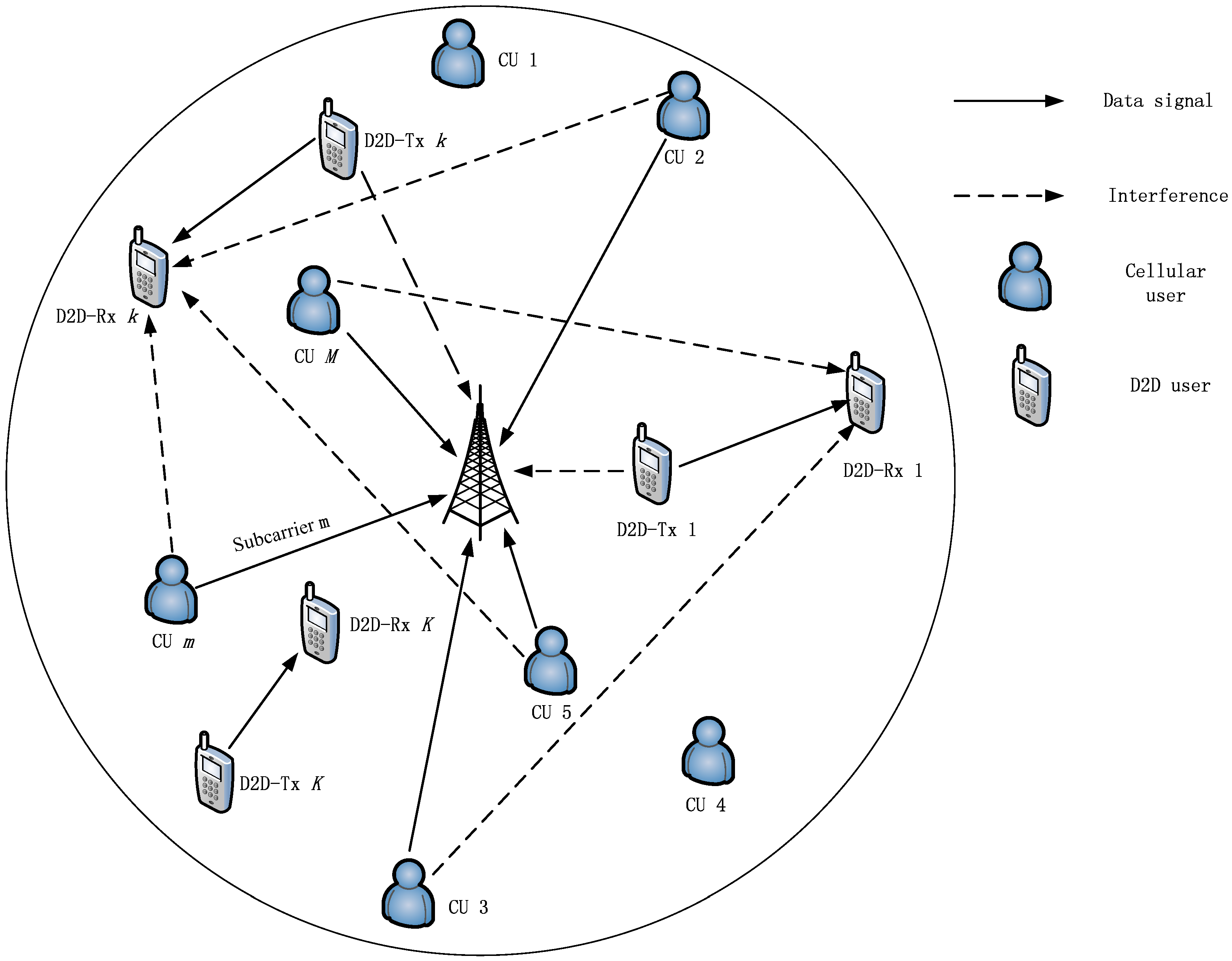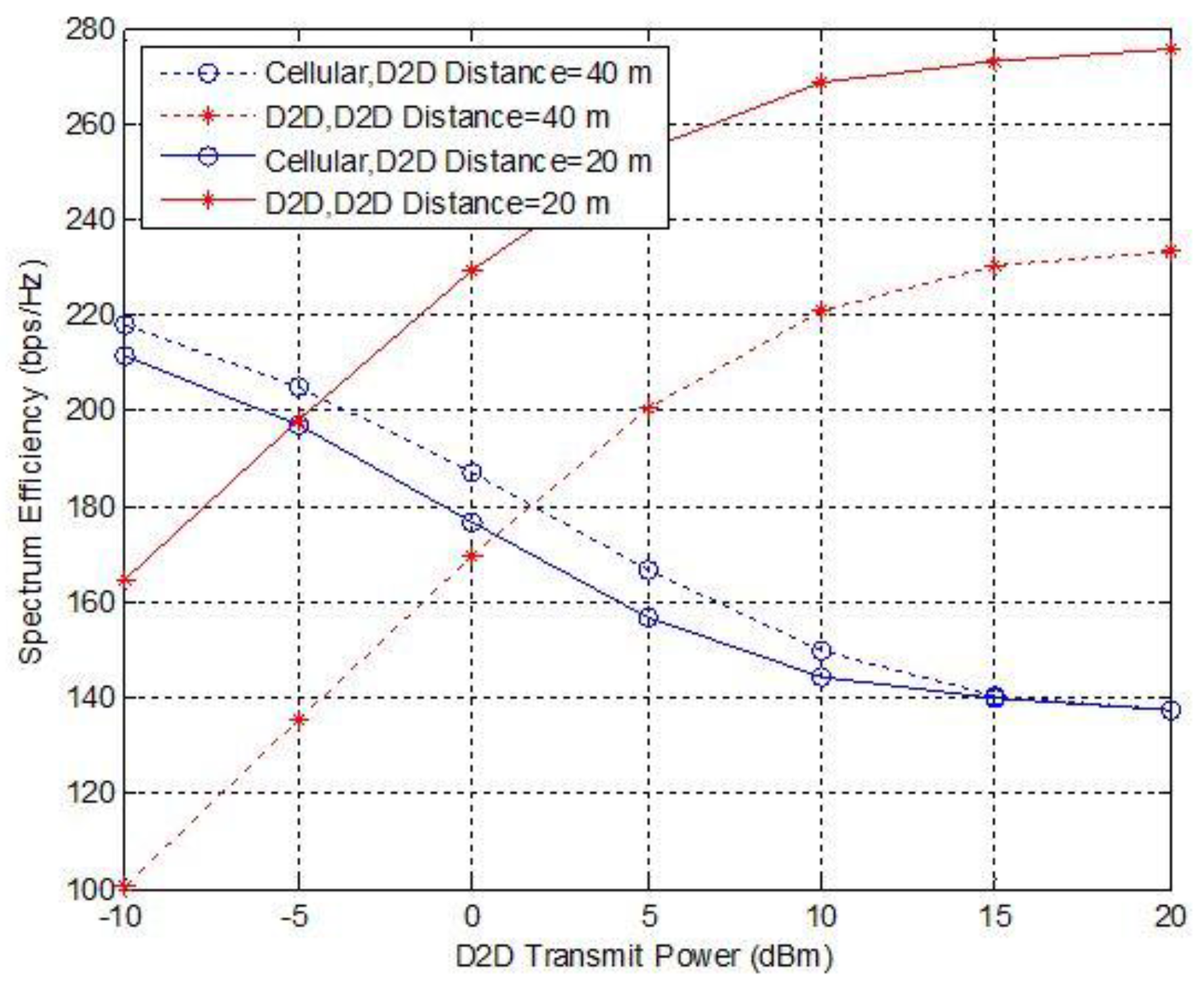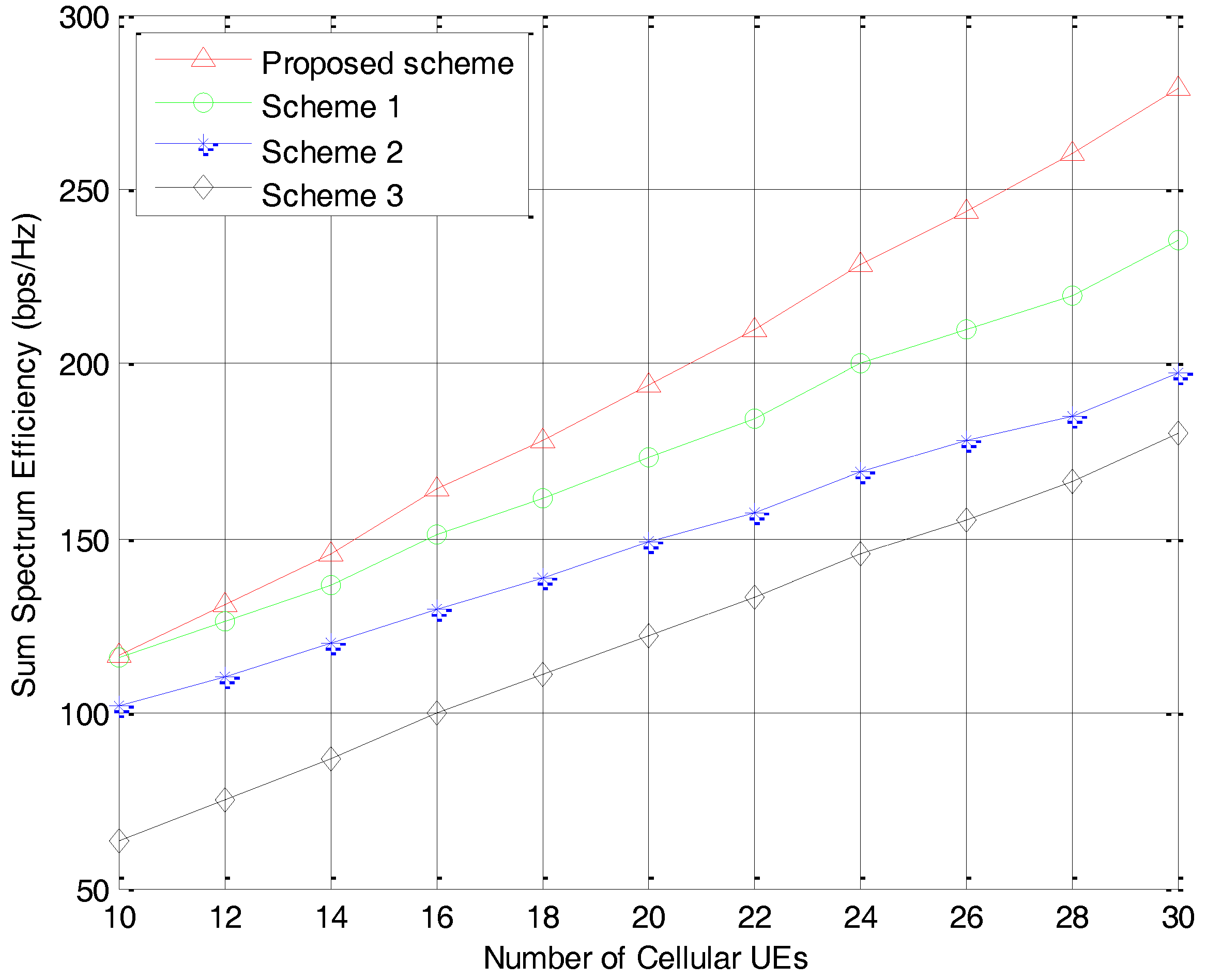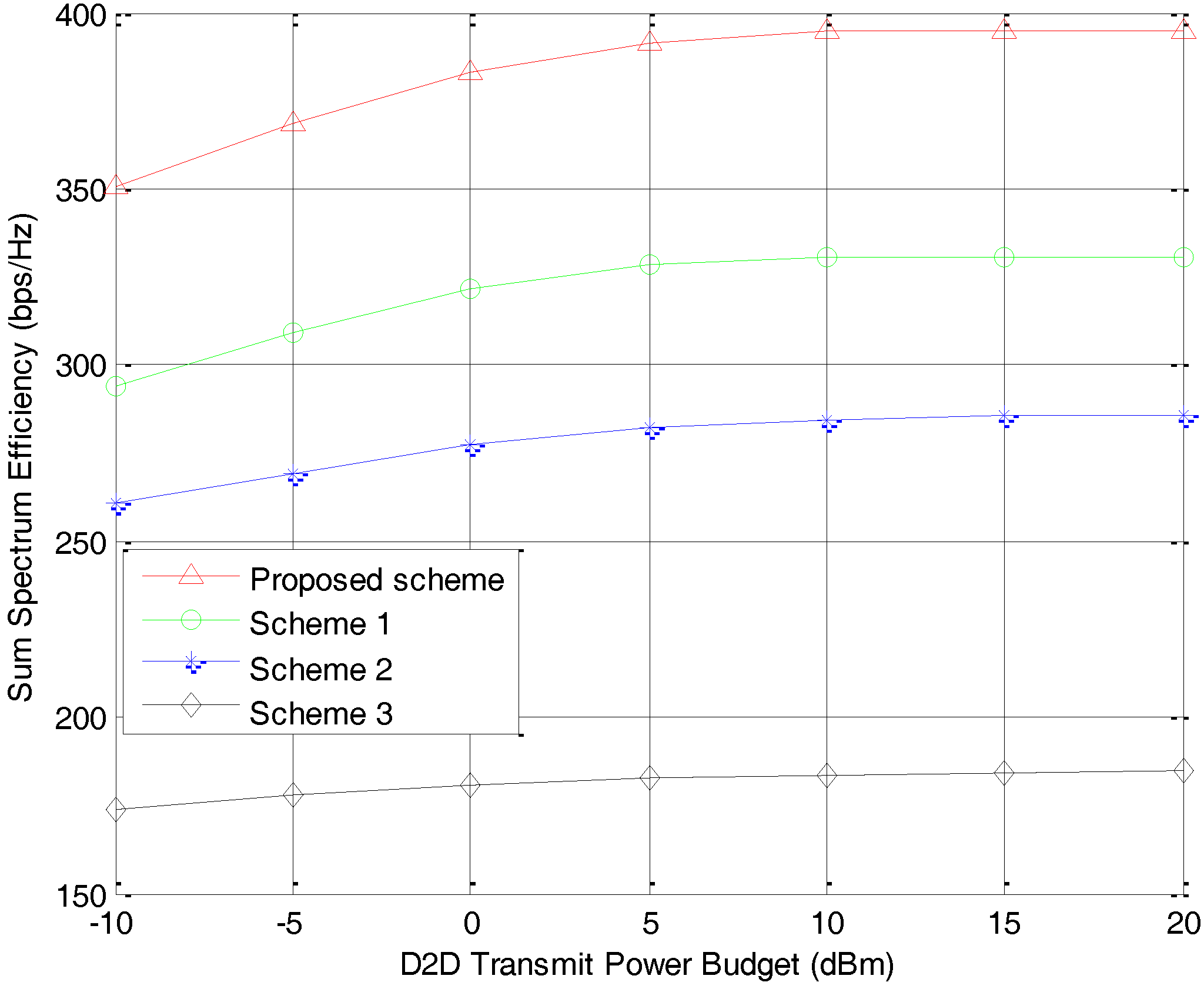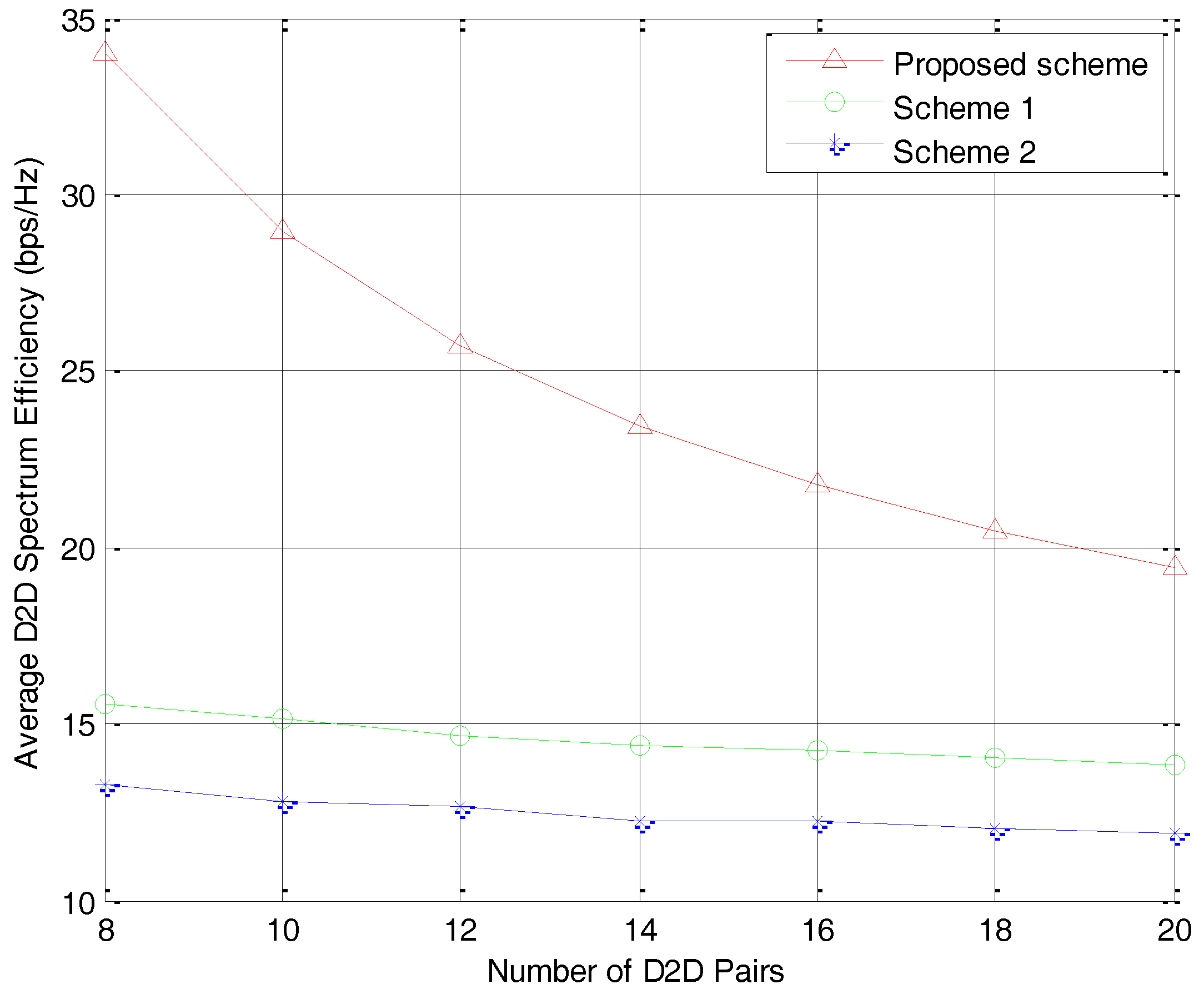1. Introduction
Device-to-device (D2D) communication has been proposed as an underlay to cellular networks where user equipments (UEs) in proximity are able to communicate directly with one another with the support of evolved node B (eNB) [
1,
2]. D2D communication pairs bring a large amount of benefits for users, such as expanding the service coverage area, increasing data rate, improving system energy efficiency, enhancing network throughput, reducing network delay, creating new types of services, and so on [
3,
4]. Additionally, the spectral efficiency could be further improved by allowing D2D users (DUs) to share the same spectrum resources with cellular users (CUs). In this case, intra-cell interference between DUs and CUs is no longer negligible so that a proper radio resource allocation strategy is needed to obtain the potential performance gains.
Most of the existing works, so far, have been carried out on resource allocation for hybrid D2D-cellular systems in order to improve spectrum efficiency and mitigate the interference between D2D and cellular communications. In [
5], an interference limited area was defined for uplink underlaying systems, where no CUs can reuse the same spectrum resource with D2D pair to avoid strong interference. Various resource reusing ways are considered in [
6], where eNB can allocate either orthogonal or non-orthogonal radio resources to CUs and D2D users. A new spectrum sharing protocol for D2D communication overlaying a cellular network is proposed in [
7], which allows the D2D users to act as a relay to assist the two-way communications between the eNB and the CUs. The authors of [
8] developed an optimal and low-complexity channel reusing algorithm to maximize the number of admitted D2D pairs. The research in [
9] focuses on resource allocation and interference management issue in D2D communication underlaying cellular networks, where the system sum-rate optimization for D2D and cellular links is considered. Both the works of Yu et al. and Jung et al. [
10,
11] consider the joint mode selection and resource allocation problem that aims to improve the sum-rate and the power efficiency. While guaranteeing the quality of service (QoS) of both CUs and D2D pairs, a centralized spectrum allocation scheme has been designed to maximize the system throughput in [
12]. In [
13], a coalitional game approach is employed to solve the joint mode selection and D2D resource allocation.
The aforementioned works generally focus on investigating the resource allocation in the case that one D2D pair could reuse only one cellular resource, even though there are much more CUs in practical networks. Actually, the system performance parameters, such as spectral efficiency, will be further improved if a D2D pair could reuse the resources of multiple CUs. Since more subcarriers are available, the DUs would have more opportunities to explore the multi-channel diversity, thereby making spectrum utilization more efficient. There are some works on resource allocation for multicarrier optimization problem in different systems. In [
14,
15], the authors propose a resource allocation algorithm design to iteratively find the optimal solution for maximization of the energy efficiency of orthogonal frequency division multiple access (OFDMA) systems based on the Dinkelbach transformation. In [
16], a resource allocation algorithm where D2D links can reuse the resources of more than one CU is proposed, while the QoS is not guaranteed for CUs. The authors of [
17] study optimal and suboptimal power allocation methods such that the D2D link can maximally utilize multiple possible cellular resources and meanwhile the QoS of CUs is guaranteed, however, they only considered a simple scenario where there only one D2D pair exists.
In this paper, we consider a system where multiple D2D links reuse the uplink resources of multiple CUs. We formulate the problem as a mixed integer non-linear programing (MINLP) problem with the objective to maximize the spectrum efficiency of the heterogeneous network. Due to the high complexity of original problem, we decompose it into two cascaded subcarrier assignment and power allocation problems. While the former is to assign subcarriers for D2D pairs by a heuristic algorithm, the latter can be solved by a power allocation algorithm based on the Lagrangian dual method. Specifically, our work makes the following contributions: (1) We investigate the optimal resource allocation for the case that one D2D pair could reuse more than one subcarrier while guaranteeing the minimum rate requirements of individual CUs; (2) We introduce the system positive gain and the system negative gain which represent the benefit of reusing cellular resources and the penalty for interference exerted on CUs respectively. The network final profit should be guaranteed (i.e., the overall system gain should be positive); (3) We develop a greedy-based algorithm to allocate one or more subcarriers to each D2D pair, as well as an efficient power allocation algorithm. The proposed resource allocation scheme can significantly improve the sum spectrum efficiency of the overall system.
The rest of the paper is organized as follows. In
Section 2, we describe the system model and problem formulation. In
Section 3, we derive and propose the two-stage algorithm to solve the resource allocation problem, and simulation results are presented and discussed in
Section 4. Finally,
Section 5 concludes the paper.
3. The Proposed Resource Allocation Scheme for D2D Communication
The optimization problem formulated in (12) is an MINLP problem. In general, MINLP problems are known to be non-deterministic polynomial-time hard (NP-hard) and no efficient polynomial-time solutions exist, as the complexity may increase exponentially with the problem size. Moreover, it is not difficult to see that the problem (12) is a non-convex function since both and are not jointly concave in .
Despite this difficulty, this section focuses on solving the resource sharing optimization problem. To proceed, we use
to denote the set of the subcarriers which are assigned to the
kth D2D pair. All
are subsets of
. Then, problem (12) can be described as
Constraint C7 represents the number of subcarriers that the D2D pair k prepares for reusing.
Problem (14) is also a MINLP problem, which still needs a large amount of calculation to find the optimal solution. We can solve it efficiently by using a two-stage approach: subcarrier allocation and power assignment, which is verified by many existing similar problems [
21,
22]. Specifically, the original optimization problem (12) is decomposed into two individual sub-problems. The first problem is a system positive gain guaranteed subcarriers assignment, where we determine the optimal reuse subcarrier set
for D2D pairs. The second problem is power allocation, where we allocate the transmitted powers for D2D pairs to maximize the sum spectrum efficiency of D2D pairs and CUs in the heterogeneous network.
3.1. Subcarrier Assignment
In this subsection, we first need to solve the optimization problem for the case that one D2D pair k shares the same subcarrier with the CU m. Then we find the optimal matching of subcarriers between the D2D pairs and CUs by exploiting the feasible local optimum power allocation. Finally, we propose a heuristic subcarrier assignment algorithm to decide the subcarrier set for each D2D pair.
Consider that the D2D pair
k shares the
mth subcarrier with CU
m. To maximize the sum spectrum efficiency of
k and
m, the considered problem can be formulated as
According the constraints C1 and C2 in problem (15), we can easily get
and we define
as the minimum and maximum possible powers of the D2D-Tx
k on the
mth subcarrier, respectively. Generally,
should be satisfied. If
, it means that D2D pair
k cannot share resources with CU
m. Then (15) can be simplified to the following problem:
where
By taking the first order derivative of the
versus
and setting the derivative to 0, we can have
With converting of the formula, (21) can be rewritten as follows:
where
Let
be the optimal solution to the problem (15). Since
, the denominator of (22) is always positive. If
,
is monotonically increasing in the interval
. We can directly obtain
. If
, the optimal solution to (15) can be obtained as follows:
where
represents the projection onto the interval
.
Next, we propose a heuristic greedy algorithm to find the optimal subcarriers assignment in order to maximize the sum spectrum efficiency. The operations of the assignment algorithm is shown in Algorithm 1. At the beginning of the allocation, the transmitters need to send some packets containing detection signals. Then, the obtained CSI at each UE (D2D or cellular receiver) would be feedback to the eNB so that various parameters can be initialized. By the previous definition, the sum spectrum efficiency brought by any D2D pair
k reusing any subcarrier
m can be roughly measured by expression
in (15). Taking the maximum sum spectrum efficiency as a target, the algorithm selects optimal D2D pairs that have the maximum
to reuse the
mth subcarrier. This procedure repeats until all subcarriers of the CUs have been assigned or cannot be assigned due to the maximum transmit power threshold being reached or because the transmit power is zero. If there are some subcarriers remaining that are still unshared by any D2D pair, we will try to allocate the remaining cellular resources to the D2D pairs that can further improve the spectrum efficiency gain.
| Algorithm 1. Greedy Algorithm for Subcarrier Assignment. |
| 1: Initialization: |
| Set , , , ; Obtain all optimum transmitting power of DU and sum spectrum efficiency by solving the optimization problem (15). |
| 2: repeat |
| 3: ; |
| 4: if and then |
| 5: Set ; |
| 6: ; |
| 7: ; |
| 8: ; |
| 9: ; |
| 10: else |
| 11: ; |
| 12: end if |
| 13: until is empty set, |
| 14: if then |
| 15: repeat |
| 16: Find ; |
| 17: if then |
| 18: Set ; |
| 19: ; |
| 20: else |
| 21: ; |
| 22: end if |
| 23: until is empty set |
| 24: end if |
| 25: return |
3.2. Power Allocation with the Given D2D Pair
Given the D2D pair
k and the subcarriers
m allocated to it, the binary variables
in (12) are identified as 0 or 1. In order to maximize the sum spectrum efficiency of overall heterogeneous network, the optimal transmission power allocated to each individual D2D pair
k should be found. Note that the set
represents subcarriers reused by the
kth D2D pair; the optimization problem of solving the optimal power allocation for the D2D pair
k can be expressed as:
According to C1 in problem (12), we can easily get
. By taking the second order derivative of the
versus
, we have
indicating that
is a concave function. Obviously, the optimization problem (25) is a standard convex optimization problem about variable
and can be solved by Lagrangian Dual method [
23]. The Lagrangian associated the problem (25) is
where
are non-negative Lagrangian multipliers for the constraints C1~C3 in (25). The dual problem of the optimization primal problem is defined as:
For any
,
is denoted as the optimal transmission power for D2D pair
k. Then, the corresponding Karush-Kuhn-Tucker (KKT) condition is as follows:
where
,
, and
are the optimal dual points. If
and
, we have
and
. Furthermore, due to the fact that
are optimal, the tendency to pursue the power maximization requires that the equation
always follows. By substituting
into (29), the value of
can be obtained as follows.
We develop a bisection algorithm to find the optimal value of
, i.e.,
. The power allocation algorithm is shown in Algorithm 2, where
and
are the upper bound and lower bound of
, respectively. Starting from a feasible value of
, i.e.,
in our algorithm, the corresponding
can be calculated by solving the equivalent cubic Equation (33). Then
is worked out. Compare
with
, if
, decrease
; if
, increase
. The adjustment procedure runs until the condition
is satisfied or
does not change.
| Algorithm 2. Bisection Algorithm for Power Allocation. |
| 1: Initialization: |
| , . |
| 2: repeat |
| 3: ; |
| 4: Calculate by solving the cubic Equation (33), with the projection of the positive |
| root onto ; |
| 5: With all the possible candidate optimal power values, the optimal transmission power |
| can be readily obtained. |
| 6: if then |
| 7: ; |
| 8: end if |
| 9: Calculate total power ; |
| 10: if then |
| 11: ; |
| 12: else |
| 13: ; |
| 14: end if |
| 15: until |
| 16: return , |
3.3. Computational Complexity Analysis
We analyze the complexity of our proposed algorithm in this subsection. In Algorithm 1, first we need to calculate all and , then we search the optimal power allocation and decide the subcarrier set for each D2D pair. The above two steps are irrelevant, and the complexity of both the two steps are . Finally, we try to allocate the remaining subcarriers to all the D2D pairs, where the complexity of the final step in Algorithm 1 is . Hence, the complexity of the subcarrier assignment algorithm is . In Algorithm 2, with as the accuracy requirement for the bisection algorithm, the complexity of the power allocation for the kth D2D pair is . Therefore, the total complexity of our algorithm is . Obviously, our algorithm has polynomial complexity which has a linear relation with the scale of and .
4. Numerical Results
In this section, we provide several simulation results to evaluate the performance of our proposed resource allocation scheme. Consider a single cell with a radius of 500 m where CUs and D2D pairs are uniformly and randomly distributed. Since the distance between D2D-Tx and D2D-Rx are relatively short, we assume all D2D pairs have the same transmitting distance. The main simulation parameters such as path loss models, shadowing standard deviation, subcarrier bandwidth, etc. are the same as these proposed in [
24]. The related parameters used in the simulation experiments are summarized in
Table 2. The tolerance ϵ is set to
.
We compare the proposed scheme with three other schemes. Scheme 1 is proposed in [
9], where throughput of multiple D2D pairs is maximized by using the Hungarian method. Scheme 2 randomly selects the subcarrier for D2D pairs to reuse and performs power allocation optimization to maximize the total achievable rate of the D2D pairs. Scheme 1 and Scheme 2 can only be applied to the case that each D2D pair could reuse only one single cellular resource. Scheme 3 is developed in [
17], where only one D2D pair has the authority to use all subcarriers.
In
Figure 2, we compare the spectrum efficiency of CUs and DUs versus the different transmit power budgets for D2D pairs, where
,
,
dBm, and
bps/Hz. From the figure, the spectrum efficiency of D2D pairs increases dramatically with the D2D transmit power budget; on the contrary, since greater power of DUs brings more serious interference to CUs, the spectrum efficiency of CUs decreases with the increasing of D2D transmit power budget. When the D2D transmit power is small, for example,
dBm, the movement of D2D transmit power has great influence on the spectrum efficiencies of DUs and CUs, which have great improved and reduced tendency, respectively. When the D2D transmit power budget is increased to some degree, it would not improve the spectrum efficiency of DUs effectively, the growth in spectrum efficiency of DUs tends to saturation. Moreover, we can see that as the distance of D2D decreases, the spectrum efficiency of DUs increases significantly, while the spectrum efficiency of CUs reduces slightly. The reason is that the smaller the D2D distance, the better the D2D channel conditions and the higher rate in D2D communications. Meanwhile, with the decrease of D2D distance (from 40 m to 20 m), the value range of D2D optimal transmit power is extended, which allows the D2D pairs to have more chance to reuse more subcarriers and causes more interference to CUs. While the D2D transmit power budget is large enough, the effect of interference caused by D2D transmit power on spectrum efficiency is more significant than that of D2D distance, and the curve becomes smooth. In addition, the increment of DUs in spectrum efficiency is greater than the decrement of CUs with the decrease of D2D distance, which implies that limiting the maximum communication distance of D2D can effectively improve the sum spectrum efficiency of the heterogeneous network.
Figure 3 shows the sum spectrum efficiency of the heterogeneous network with different number of CUs, where
,
m,
dBm, and
bps/Hz. Note that we assume the number of CUs equals the number of subcarriers, since each subcarrier is occupied by a CU. We observe that the sum spectrum efficiency goes up with the number of CUs increasing in all compared schemes, which indicates that more DUs contribute to a higher system sum spectrum efficiency. From the figure, our proposed scheme, i.e., the scheme of reusing multiple subcarriers, performs much better than the other three schemes. In particular, when the number of CUs is relatively small, for example,
, the performance of the proposed scheme is close to Scheme 1. With the increasing number of CUs, the absolute performance gap expands. The relative performance gap when there are 30 CUs is about 19%. This is due to the fact that each D2D pair can use more subcarriers as the number of CUs increases in the scenario of reusing multiple CUs’ subcarriers. Obviously, Scheme 3 has the lowest sum spectrum efficiency. This is due to the fact that only one D2D pair gets involved in resource sharing; as a result, there may be many cellular subcarriers that may not be reused, leading to inefficiency in resource utilization.
The sum spectrum efficiency of the heterogeneous network with different D2D transmit power budget is illustrated in
Figure 4, where
,
,
m, and
bps/Hz. Intuitively, the sum spectrum efficiency rises with the increase of D2D transmit power budget. Since the total power can be allocated to multiple subcarriers of multiple D2D pairs, our proposed sharing scheme exhibits the best performance and the largest increases in sum spectrum efficiency. In addition, the sum spectrum efficiency increases rapidly in the lower D2D transmission power case. When
dBm, the growth curve becomes smooth, which implies that the sum spectrum efficiency starts to saturate and the D2D transmit power does not have a major impact on the performance improvement.
Figure 5 shows the sum spectrum efficiency with different rate requirement of the CUs, where
,
,
m, and
dBm. Similarly, it is obvious that the proposed scheme performs much better than the other three. Moreover, with the increasing rate requirements of CUs, the sum spectrum efficiency of the heterogeneous network decreases slightly. With higher rate requirements, more transmission powers for CUs are needed to meet the required QoS, and thus more D2D pairs that share the same subcarriers with these CUs are restricted, resulting in that only the D2D pairs which generate low interference to the eNB can reuse the subcarriers.
Figure 6 plots the sum spectrum efficiency of the heterogeneous network with different D2D pairs, where
,
m,
dBm, and
bps/Hz. We observe that with the increase of D2D pairs, the proposed scheme shows a trend of rapid growth in sum spectrum efficiency and outperforms other schemes, whereas the performance of Scheme 3 remains nearly unchanged. Since the performance of D2D communication on spectrum efficiency is far better than that of traditional cellular communication, multiple D2D pairs reusing multiple subcarriers can achieve a much higher throughput than reusing only single subcarrier (Scheme 1 and Scheme 2), or a single D2D pair reusing multiple subcarriers (Scheme 3). We also compare our proposed sharing scheme with Scheme 1 and Scheme 2 on the performance of average D2D spectrum efficiency. From
Figure 7, It is obviously that the average D2D spectrum efficiency decreases with the increasing number of D2D pairs. The reason is that with more D2D pairs entering the network, the average available subcarrier per D2D pair reuses is fewer, resulting in a performance penalty. In addition, the performance degradation of the proposed scheme is more significant, which indicates that the performance of the proposed scheme is more sensitive to the number of available subcarriers.
